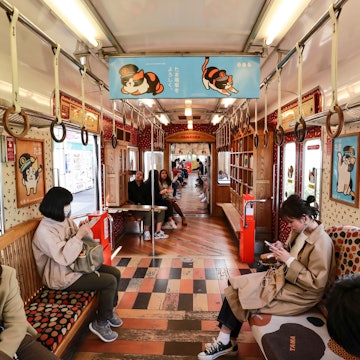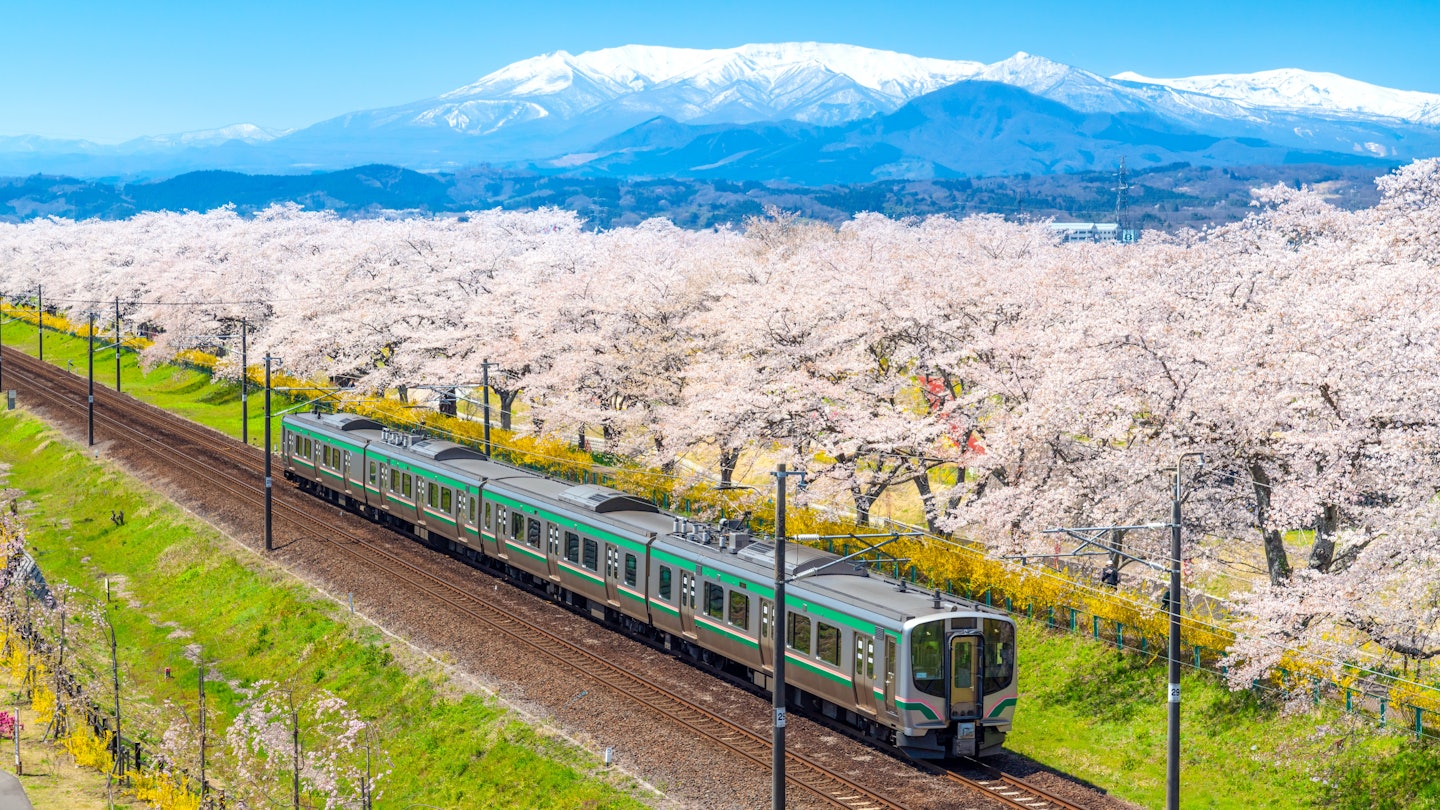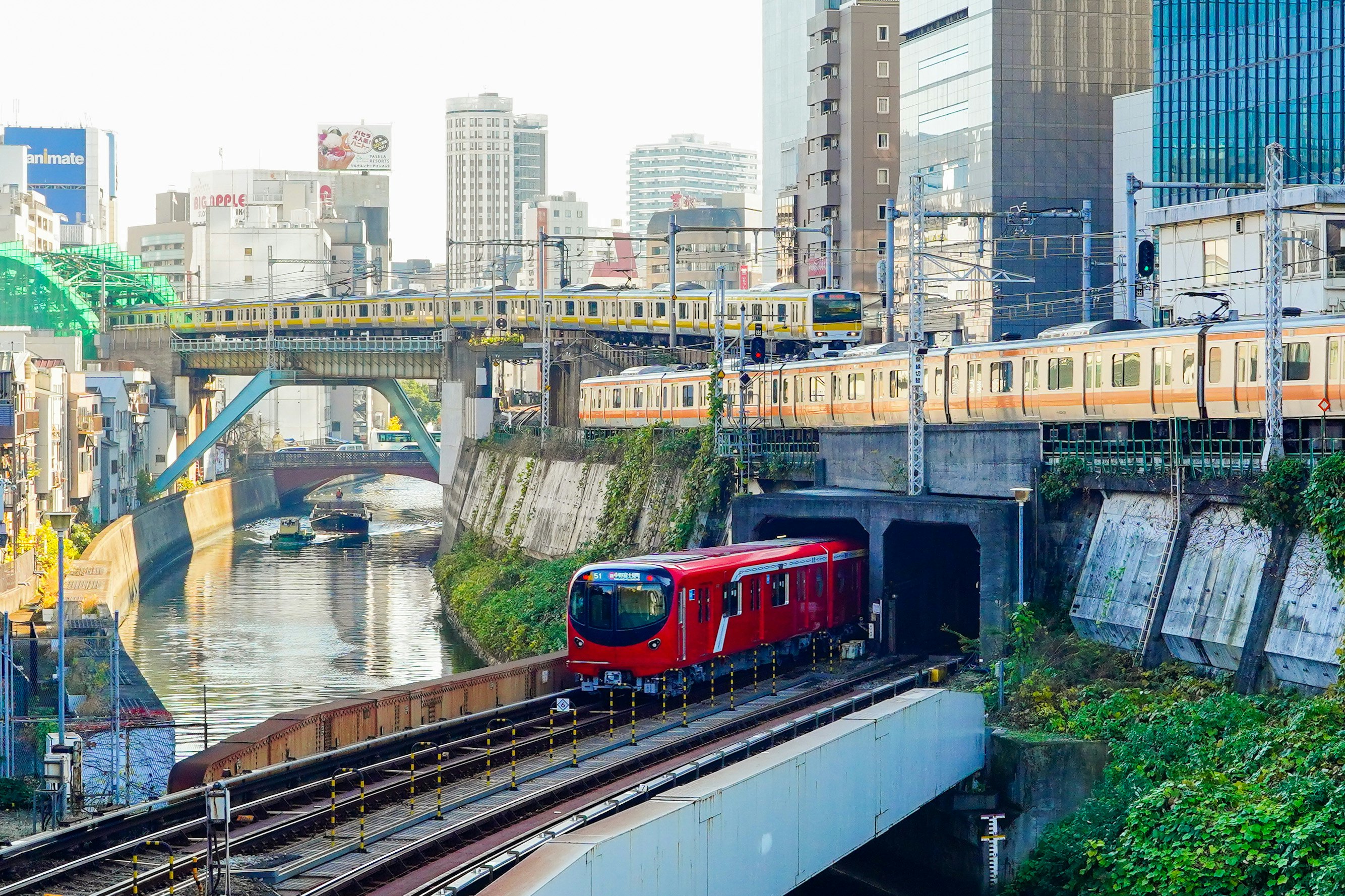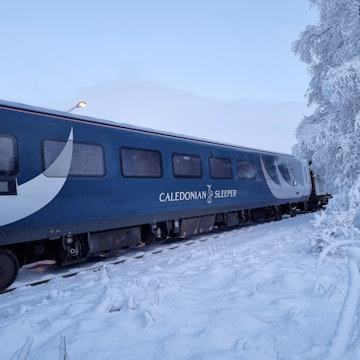

Get on the rails with our ultimate guide to train travel in Japan. Chay_Tee/Shutterstock
Japanese people didn’t invent rail travel, but they arguably perfected it, and we guarantee that you will fall passionately in love with trains when you visit Japan.
Whether you’re on the newest Shinkansen (bullet train) zooming across the country at 320km/h (199mph) or rattling gently on an old-fashioned regional railcar, you can count on your train being scrupulously clean, safely operated, highly reliable, famously punctual and generally a joy to ride.
Thanks to Japan's excellent rail network, you can see almost the entire country by train, and with a wide variety of rail passes — including the iconic Japan Rail Pass — you can travel across Japan for less than US$50 per day, including on board the Shinkansen. It's the ideal way to take in Japan's top cities and sights.
While Japan has a reputation as a tricky place to travel if you don't know the language, signs are in English even at the smallest stations. Translation apps and devices can help with complicated questions, and staff are genuinely happy to help travelers.
Japan has an enormous number of train lines and many different kinds of trains, but don’t be put off by the scale of the network; the country is surprisingly easy to navigate by train, even on your first trip, with your phone’s maps app and a sense of adventure. Here's what you need to know before you set off on the rails.

Many different services operate on the Japanese train network
Trains run almost everywhere in Japan. The main backbone of the network, and the fastest way to travel, is the Shinkansen, operated by Japan Rail. These bullet trains run from Hokkaidō in the far north all the way to Tokyo Station, where you have to change for the Shinkansen going to Nagoya, Kyoto, Osaka, Hiroshima and on to Kyushu. If you plan to visit Japan’s top sights, this will be the kind of train you take the most.
The next fastest trains are Limited Express services – with “limited” meaning “limited stops.” These trains run between cities and rural areas on pre-Shinkansen-era railway lines (ie the non-high-speed ones). Many routes pass through beautiful parts of Japan, so don’t count them out. Local trains are the slowest and may even be as small as a single car. “Rapid” trains are fairly rare, and are essentially local trains that skip a few of the smaller stops.
Urban rail, commuter trains and subway lines are widespread in cities. These transit systems are similar to what you might be used to in your home country, although network maps can be confusing for the uninitiated. Watch out for semi-express services which stop at fewer stops, particularly during rush hour.
While transit maps can look a little intimidating, most major cities now have a system of colors and station codes in place to help you navigate, so you won't have to rely on recognizing the name of your stop in Japanese. Your phone's maps app is a good place to get a quick idea of how to get from A to B by rail.

Look out for Japan's special "Joyful Trains"
Confident visitors interested in seeing more of the countryside around major cities will love Japan's Joyful Trains, which are special tourist trains operated largely on weekends and holidays in rural areas. These might be renovated steam trains, or journeys with a special theme.
JR East’s Koshino Shu’Kura is all about sake, including tastings, while the JR Kyushu A Train is jazz-themed, and the JR SL Gunma is pulled by a vintage steam engine. Check online for the options where you plan to travel.
Get more from Japan's train stations
Japan’s train stations are almost destinations all by themselves, with larger and newer stations offering a huge range of restaurants for every appetite and budget, and shops selling everything from high-quality handmade artisanal goods to fresh produce, as well as mini shopping malls and 100-yen stores.
Convenience stores and pharmacies are also found at many stations selling snacks and travel essentials. Look out for special local snacks in station omiyage (souvenir) shops – these are intended for Japanese travelers to take back to friends and colleagues as presents). Also look out for ekiben – local specialty bentō box lunches, sold at stations and on some trains.

Travel short distances with a prepaid travel card
If you come from overseas, traveling short distances on Japanese railways often feels very inexpensive, while traveling longer distances without a rail pass can feel painfully expensive. But there are ways to save on both long and short journeys.
Taking subways and urban rail services is simple if you get an "IC card" – the umbrella term for a range of prepaid stored-value contactless cards used for public transit in Japan. These cards work in a similar way to Oyster cards in London or the Clipper card in San Francisco – just tap on and tap off.
Most rail operators across Japan will sell you their version, and these cards are almost all interchangeable when it comes to loading credit and paying for rides. For example, you can use an ICOCA card from the Osaka region in Tokyo, or a Pasmo card from Tokyo in Sapporo.
You can also your iPhone to get a virtual version of the Suica card (JR East's prepaid card) via the Wallet app, and then load it with money using Apple Pay. If you're using an international Visa card, be aware that JR East has had issues processing these kinds of payments in the past, so you may need to use a different credit card.

Japan has many rail passes to choose from
Japan has a wide variety of rail passes available to overseas visitors. The JR Pass is valid across the JR network – with a few exceptions, like the very fastest trains running west from Tokyo – but there are also regional and commuter passes. Adventurous travelers and long-term visitors, or anyone wanting to explore a particular region in depth, could also consider the following passes.
Various regional passes from JR East, including the very useful Hokuriku Arch Pass for traveling the slow way between Tokyo and Osaka via Kyoto and Kanazawa
Various JR West Passes, including the All Area Pass, covering most of western Honshu
To buy a pass, you usually need to be visiting Japan with a “temporary visitor” stamp in your passport, and there may be a small discount (a couple of thousand yen or US$5–10) if you buy the pass online or outside Japan. If you are buying a pass in Japan, check out the details online or visit a large station, where staff are more likely to speak English.

Travel long distances with the JR Pass
Over longer distances, the Japan Rail Pass is generally a good deal if you are planning anything more ambitious than the Tokyo–Kyoto–Hiroshima–Tokyo circuit, and the flexibility it gives you to take an earlier or later train is an added bonus. This is probably what you should get for your first trip to Japan if traveling outside Tokyo.
The pass is valid for 7, 14 or 21 days, and you can choose from just standard car travel, or travel in the business-class Green Car. Prices start at ¥50,000 (about US$320) for seven days in standard class – less than US$50 a day! This covers unlimited rides on JR trains during the period of validity.
You can either buy the ticket online or from an overseas travel agent. Note that you don’t actually buy the pass itself from overseas — you buy a voucher called an Exchange Order, which you can then exchange at a major train station (or any of Japan's international airports) for the pass itself.
If you don’t have a pass, tickets can be purchased at stations and cost the same no matter what time of day you travel, where you book, or how busy the trains are. It’s not like airline tickets where prices can change wildly. Most overseas travelers still use paper tickets for everything apart from local urban travel.
Long-distance travel fares are based on both the ticket price (determined by the distance you travel) and whether you want to reserve a seat, and in which class. Limited Express and Shinkansen trains offer non-reserved seat tickets, reserved seats in standard class, reserved Green Car (business class) seats, and in some regions, reserved seats in Gran Class (first class).

Tickets can be bought at stations or at JR Travel Service Centers
For JR trains, visit the local JR station (look for the “green window” marking the ticket booking office) or a JR Travel Service Center, where you can also reserve a seat. Book tickets for smaller local companies at stations, and use Google Maps or the Japan Transit Planner from Jorudan to find fares.
At major airports and in Tokyo, you can expect some basic train-related English to be spoken by "green window" ticket agents, whereas staff at JR Travel Service Centers tend to be more multilingual. Elsewhere, if you speak no Japanese you may get lucky with someone who speaks English, and you can always lean on your phone's translation apps.
When trying to buy a ticket, write down, print out or display on your phone screen the dates, times, destinations and details of the train you want to overcome language barriers – for example: "12 April, Tokyo–Osaka, 12:00, window seat, Mt Fuji side please."
Unless you’re visiting during a major Japanese holiday or want to take a specific Joyful Train, there’s rarely any need to book before arriving in Japan. You can book some services online, but it’s pretty complicated and we wouldn’t recommend it to first-time visitors!
If you’re confused and want English-speaking advice, head to one of the major stations that specializes in Japan Rail Passes. Only a few trains outside the JR network allow pre-booking.
Train etiquette means not disturbing fellow travelers
Japanese urban trains can be famously crowded during rush hour, but even Tokyo is not really any worse than any major global city. Even when trains are crowded, the etiquette is to be as quiet as possible, show respect for other passengers, and disturb others as little as possible. This means keeping your headphones quiet, avoiding loud conversations, wearing your backpack on your front and giving up your seat to anyone who needs it more than you.
There is something of a stereotype of loutish tourists yapping away loudly to their traveling companions on long-distance trains in Japan, so try not to contribute to it. Separate your trash into the correct recycling bins, and always leave the seat as clean and tidy as you found it.
Eating and drinking is fine (and even encouraged!) on longer-distance trains, but there's an unwritten rule that this is inappropriate when sitting in subway-train-style seats facing toward other passengers across the aisle – such as the seats found on urban commuter trains. If the seats are airline-style, facing forwards, you should be fine. If in doubt, follow the lead of older Japanese passengers in the carriage.

On-board facilities vary depending on the service
With the exception of the Joyful Train tourist services, Japanese trains don’t have buffet cars, although you can see what they used to look like at several of Japan’s excellent railway museums. A shrinking number of trains still have a trolley service offering snacks, sometimes bentō boxes and a variety of drinks.
If you need to fuel up, any station larger than the tiniest rural halt will have a convenience store inside or nearby, vending bentō boxes, hot meals, snacks, drinks and other essentials. Many larger stations have expansive restaurant complexes, while some smaller ones will have smaller snack food options like a soba or ramen noodle shop.
Long-distance trains usually have toilet facilities, with newer ones (including all Shinkansen trains and some Limited Expresses) also having excellent facilities for disabled passengers and people with reduced mobility. If you need to power your tech, Shinkansen and newer Limited Express trains offer two-pin, US-style 110V charging ports, while wi-fi is also increasingly available and easy to connect to.
Most Japanese trains are not set up for luggage bigger than a small carry-on case – few trains can accommodate anything as bulky as a bicycle! On some trains, you will need to pre-reserve a space for larger luggage. Take advantage of nationwide luggage shipping services such as Yamato (known as Kuroneko Yamato because of its black cat logo) – they can ship larger bags to your destination for US$10–20.
Consider the seat you are booking if you want great views
Our advice is to always take a window seat! You'll want to take in the views whether you’re gazing out on Japan’s sprawling megalopolises from an urban train, watching the country fly by from a Shinkansen, or enjoying picturesque views from a slow rural train.
On the Shinkansen, if you want the best mountain views – including vistas of iconic Mt Fuji on the trip between Tokyo and Shizuoka – select a window E seat in standard class, or a D seat in the Green Car. Limited Expresses are wonderful for countryside views – the Hida train from Nagoya to Toyama through the Japanese Alps and the Inaho train from Niigata to Akita are two standout journeys.

Ask for help when navigating busy city networks
Urban trains, commuter rail and subway routes may have confusing names and complicated stopping patterns, especially during rush hour, but this is no worse than figuring out what a “Watford Semi-Fast” is on London’s Tube or how skip-stop works on the subway in New York.
As a visitor, just ask station staff or, in a pinch, a fellow passenger – and be prepared to get on the wrong train with a confident smile and a sense of affable adventure. If you go off course, someone will usually be able to put you right!
The majority of trains are wheelchair accessible
A significant majority of intercity, urban rail and subway stations in major cities – including 80–90% of stations in Tokyo) are accessible for wheelchair users, with widespread elevators, stair-climber lifts and ramps. However, be aware that older stations, such as the main Tokyo Station, can be complex and accessible only from certain entrances. Tactile strips to assist people with sight issues are found almost everywhere.
Accessible Japan is an excellent resource for information, while the very detailed For Safe and Convenient Accessibility website offers a search engine for accessible routes and stations as well as a support line for further assistance. Station staff will be keen to help wherever they can.
Many trains offer spaces set aside for wheelchairs, step-free boarding, or boarding ramps if you need them. Urban rail and subways have priority seating for people with mobility issues, and Japan developed the Help Mark badge system for people with invisible disabilities to easily signal their needs.
You can obtain a Help Mark badge for free from a number of locations in Tokyo, or order a badge online for under US$10 from Amazon Japan (consider having it delivered to the hotel where you are staying on the first night).
















